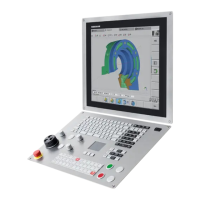DIN/ISO programming | Programming variables
4
HEIDENHAIN | User's Manual smart.Turn and DIN Programming | 12/2017
463
Tool compensation
#dt(n): n is the compensation direction (X, Z, Y, S) and t is
the turret pocket number assigned to the tool. The variable
calculation uses the table toolturn.htt. Simulation: When
the program is selected, the table toolturn.htt is read by the
simulation. The simulation function now uses the table of the
simulation
Example:Tool compensations
. . .
N.. G1 X(#m1(X)*2)
N.. G1 Z#m3(Z)
N.. #m4(Z)=350
. . .
Tool information can also be interrogated directly via the
ID no.. This may be necessary, for example, if no turret
pocket has been assigned. For this purpose, program
a comma and the ID no. of the tool after the desired
identification, e.g. #l1 = #d1(Z, "001").
Event bits
Event bits: Variable programming interrogates a bit of the event
for 0 or 1. The meaning of the event is determined by the machine
manufacturer.
#en(key): n is the channel number and key is the event name.
Used for reading external events set by the PLC
#e0(key[n].xxx): n is the channel number, key is the event
name and xxx is the name extension. Used for reading external
events set by the PLC
Example: Event bits
. . .
N.. #g1 = #e1( "NP_DG_Achs_Modul_warten")
N.. PRINT( "NP_DG_Achs_Modul_warten=",#g1)
N.. #g2 = #e1( "DG_DATEN[1]")
N.. PRINT( "DG_DATEN[1] =",#g2)
N.. #g3 = #e1( "SPI[1].DG_TEST[1]")
N.. PRINT( "SPI[1].DG_TEST[1] =",#g3)
. . .
N.. IF #e1( "NP_DG_Achs_Modul_warten")==4
N.. THEN
N.. G0 X40 Z40
N.. ELSE
N.. G0 X60
. . .

